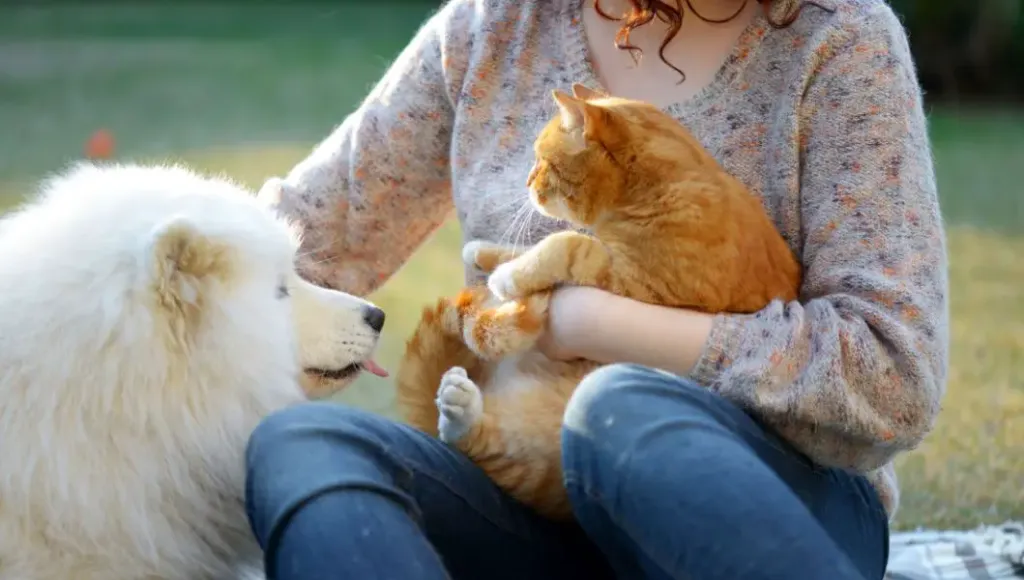Samoyed Dog: Learn all about this smiling furry friend
The Samoyed dog looks like a big white plush bear, with its fluffy white fur and friendly face. In Brazil, they are not very common, but they are becoming increasingly popular among pet owners every day. Intelligent and highly social, they are perfect for families with children. Their companionship and enthusiasm are unparalleled, and they love interacting with family and friends. Let’s learn about the origins, characteristics, and a little more about this smiling furry friend! Enjoy reading and have fun!

Spitz Dogs
Before we discover the origin of the Samoyed dog, we need to talk about Spitz dogs. Are you familiar? Spitz dogs are a group of canine breeds with similar characteristics. The word ‘spitz’ in German means “point” or “pointed,” referring to the ears of this type of dog. The Siberian Husky, the Pomeranian, the Akita Inu, and the Samoyed dog itself are examples of Spitz dogs. If you look closely, they all have pointed ears, dense fur, and a short muzzle. Each breed has its distinct characteristics, but they all share a heritage and adaptations to cold climates.
Origin of Spitz Dogs
Speaking of ‘heritage,’ what is the origin of this group of dogs? Descendants of primitive dogs that existed in various parts of the world, Spitz dogs have a very ancient origin, dating back thousands of years and carrying traits of wolves. As dogs adapted to extremely cold climates, it is believed they originated in regions of Northern Asia and the Arctic. Over the centuries, various other Spitz dog breeds developed in different regions, all sharing the same main characteristics.

Origin of the Samoyed Dog
Samoyed People
The Samoyed people are a group of peoples from northern Siberia who share a language family known as Uralic languages. They are not an ethnic group or tribe since they do not have a specifically unique culture but rather a linguistic group. The term “Samoyed” is already obsolete in its place of origin, Russia, and was used to refer to some indigenous peoples of Siberia.
Why are we talking about this? Because it is believed that the Samoyed dog originated among these people.

Samoyed Dog
The Samoyed dog, like Spitz dogs, has a long history. Originating in the Siberian region of Russia, it was primarily bred as a service dog for the Samoyed people, whose origins date back to prehistory. The Samoyed dog’s strength and ability to withstand the extreme cold of the Arctic set it apart. It was used to pull sleds during nomadic migrations, as well as assist in herding and hunting.
The bond between the Samoyed dog and the Samoyed people was very close. Not only were they highly valued for their services, but they were also considered important members of the group or tribe they belonged to. They were treated with affection and respect, sharing an intimate bond with their guardians.
The Samoyed dog breed is known for being active and well-suited for cold climates. They are a large breed of dog with a friendly and gentle personality. Samoyed puppies are adorable and make great companions. When compared to other dogs, Samoyeds have unique qualities that make them stand out among dog breeds.

Physical Characteristics of the Samoyed Dog
In addition to the characteristics shared by all Spitz dogs, the Samoyed dog has distinct and unique features. Let’s look at some:
Expression:
If you look closely at a Samoyed dog, you will have the impression that it is smiling at you. Its bright eyes and friendly expression convey exactly the affectionate personality of the breed.
Body Structure of the Samoyed Breed:
The Samoyed dog breed has a robust yet elegant body. Its upright posture and well-developed musculature give it a touch of vigilance and sophistication.
Size:
Samoyed dogs are considered medium to large-sized dogs. An adult male measures around 24 inches in height, while an adult female measures between 19 and 21 inches. In terms of weight, there is also sexual dimorphism: females weigh between 35 and 50 pounds, while males weigh between 45 and 65 pounds.
Appearance:
What stands out most in the Samoyed dog, apart from its smiling and cute face, is its dense and entirely white or cream-colored fur. Its coat is double, protecting it from extreme cold. Its ears are pointed and always upright, as if constantly on alert. Almond-shaped, round, and dark eyes, usually brown or chestnut. Its nose is also dark, black, or brown, and it has a moderately long muzzle. The Samoyed dog’s tail has, or at least originally had, the exact length to protect its face from the cold if it needed to sleep outdoors.
Behavior
Its friendly and happy face corresponds very well to its temperament. The Samoyed dog is a highly social, gentle, and loyal dog. They are known to be excellent companions for all ages, including children. This partnership and strong bond with humans are largely due to their intimate coexistence with the Samoyed people, where they originated.
This closeness to their humans means they need attention and company and can become bored and stressed if left alone for long periods. Despite being alert and barking to warn of strangers, they still get along well with them, being friendly and receptive to unknown people.
They are very intelligent and learn tricks quickly, having an above-average learning ability, although they can be a bit stubborn while learning. They are cheerful and full of energy, playful, and love outdoor activities. When they are happy, they tend to show joy by jumping, barking, and wagging their tails.

Samoyed Breed and Living with Other Pets
The exact behavior of a Samoyed towards other animals can vary from individual to individual, and early socialization is crucial to ensure that the dog grows up being friendly with pets of other breeds.
In general, Samoyeds tend to exhibit the following characteristics regarding living with other pets:
• Friendly:
Samoyeds are generally friendly with other dogs and pets, including cats. They have a sociable nature and enjoy interacting with animals of other breeds.
• Hunting Instinct:
While they are friendly, it’s important to note that the Samoyed has a hunting instinct, as it was originally bred for herding and hunting. Therefore, early socialization is essential to ensure that they do not see smaller animals such as rabbits or birds as prey.
• Playful:
Samoyeds are known to be playful and may enjoy interacting with pets of other breeds through play.
• Tolerant:
They generally have a tolerant disposition and can be patient with younger or smaller pets.
• Initial Monitoring:
As with introducing any new pet, it’s important to monitor the initial interaction between the Samoyed and other pets. This is especially crucial if the Samoyed lacks prior experience with pets of other breeds.
Remember that proper training and early socialization are essential to ensure that your Samoyed gets along well with other pets. Supervision and gradual introductions are key, especially when introducing a new pet to the household.

Necessary Care
• Physical activities and interaction
A happy puppy is a well-cared-for puppy, right? And with the Samoyed dog, it’s no different. Some very specific care is needed for this breed. One of them relates to physical exercises. As they are very active dogs, remember that originally, they were service dogs, and their physical and mental health can be seriously affected if they do not have the proper amount of physical activity and mentally stimulating activities.
Long walks and large spaces to run and play are essential for this dog breed. No owner wants a dog barking incessantly indoors and certainly not chewing and destroying furniture, right? So, take them for a walk daily! The Samoyed dog needs to expend its energy to feel happy and calm. Despite adapting easily to a variety of environments, keeping such a dog locked inside an apartment or house is not recommended.
Remember, we mentioned earlier about their companionship and sociability with humans? This is also an aspect that requires care because they cannot be left alone for too long as they crave attention and affection.

• Hygiene and well-being
They are big, active, and very furry! And now, how to take care of all that fur? The dense fur of the Samoyed dog also requires special care. To stay clean and free of knots and tangles, its fur should be brushed at least three times a week. Twice a year, during the shedding period, the number of brushings should be increased, preferably daily.
Despite the light-colored fur, white or cream, they don’t need many baths, believe it or not. This is because their fur is thick and dense, preventing the accumulation of dirt. An adult Samoyed dog needs a bath every 3 months, but don’t forget the constant brushing of the fur.
Regarding oral health, natural feeding is an effective ally, did you know that? Check out this article from our partner site, Pet and Pals, and see tips on foods that help keep your dog’s teeth healthy.
Despite all the care tips we bring here, remember that the supervision of a veterinarian is essential, okay?

Conclusion
Before buying a puppy, always remember the thousands waiting for a family in the many animal NGOs and shelters. But if you choose to acquire a Samoyed dog, look for reputable breeders and always inquire about the “parents” of the puppy.
Did you fall in love with that smiling and friendly face? We did! We hope you enjoyed learning a little more about this dog breed, so different and unique.
Until next time!♥




